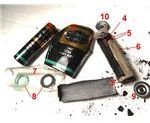Dry Cell History and Advances
The first dry cell was invented in the late 19th century. It used zinc as an anode, manganese dioxide as an “earthode,” and a gelled, moist mixture of ammonium chloride and zinc chloride as electrolyte.
Later they created a dry cell made up of carbon as a cathode, zinc as an anode, and sal-ammoniac paste as an electrolyte. This type of dry cell is commonly known as a carbon zinc Leclanche cell. Even today, most of the dry cells manufactured are of this kind due to its lower manufacturing cost and its being suitable for all applications requiring intermittent current, such as used in flashlights and transistor receivers.
These cells have a few drawbacks such as their low energy density and limited lifetime. In later years, a large number of new types of dry cells were developed for new and different applications.
Modification in Leclanche Cell to become a Dry Cell
The glass in Leclanche cell is replaced by a zinc container, and the ammonium chloride solution is replaced by a moist sal-ammoniac paste.
The Dry Cell is a Primary Cell
The cells from which electric energy is derived by irreversible chemical action are called primary cells. The primary cell is capable of providing an EMF when its constituent’s two electrodes and a suitable electrolyte are assembled together. The three main primary cells namely are the Daniel cell, the Leclanche cell, and the dry cell. None of these cells can be recharged electrically.Prev Year Paper,Answers,Solutions by Top IITians, See JEE AnalysisHow Chemical Energy is converted into Electrical Energy in Cells
Chemical effect of current
Conversion of electric energy into chemical energy: the passage of an electric current through a liquid causes chemical changes through a process called electrolysis. Conduction is possible only in liquids wherein charged ions can be dissociated in opposite directions. Such liquids are called electrolytes, and the plates through which current enters and leaves an electrolyte are known as electrodes. The electrode towards which positive ions travel is called the cathode, and the electrode towards which negative ions travel is called the anode. The positive ions are called cations and negative ions are called anions.
Effect of Chemicals in Batteries
Conversion of chemical energy into electrical energy: in this case, the reverse process takes place due to the chemical reaction between two electrodes in the presence of an electrolyte and an electric current is produced.
Faraday’s Laws of Electrolysis
First law:
The mass of a substance liberated at an electrode is directly proportional to the charge passing through the electrode.
Second law:
The mass of a substance liberated at an electrode by a given amount of charges is proportional to the chemical equivalent of the substance.Working of a Dry Cell:
Parts:
Anode (Negative Terminal): Zinc
Cathode (Positive Terminal): Carbon coated with MnO2
Electrolyte: Mixture of plaster of Paris, Ammonium Chloride and Zinc Chloride
Dry cells contain a Zinc container which itself acts as a negative electrode. The moist paste is made from a mixture of plaster of Paris, Ammonium Chloride, and Zinc Chloride called sal ammoniac paste. This forms the electrolyte of the cell and takes up the major amount of volume in the battery. Zinc Chloride is hygroscopic in nature and helps to maintain the moistness of the paste. It is wrapped in a canvas sheet.
- Anode reaction: The oxidization of Zinc gives two electrons.
The carbon rod forms the positive electrode. It is coated with MnO2 and powdered carbon. The powdered carbon reduces the internal resistance of the cell. The top of the cell contains a layer of sawdust. This acts as the base for the top layer of bitumen used for sealing purposes.
- Cathode reaction:
- Electrolyte reaction: Hydrogen from Ammonium chloride
- Overall reaction in dry cell:
A vent is provided in this layer to allow the gases formed in the chemical reaction to escape. Irrespective of the size of the dry cell, the EMF is 1.5 V because the zinc and carbon rods used as electrodes specified a chemical equivalent. The chemical equivalent changes from metal to metal and, depending on the type of combination used, the EMF differs.






0 comments:
Post a Comment